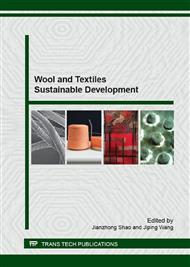[1]
Sawada, K., et al., Optimization of dyeing poly(lactic acid) fibers with vat dyes. Dyes. Pigm. 2007. 74: pp.81-84.
DOI: 10.1016/j.dyepig.2006.01.015
Google Scholar
[2]
Blackburn, R.S., et al., Effect of d-isomer concentration on the coloration properties of poly(lactic acid). Dyes. Pigm. 2006. 70: pp.251-258.
DOI: 10.1016/j.dyepig.2005.05.011
Google Scholar
[3]
Yang, S., et al., Characterization and biodegradation behavior of bio-based poly (lactic acid) and soy protein blends for sustainable horticultural applications. Green Chem. 2015. 17: pp.380-393.
DOI: 10.1039/c4gc01482k
Google Scholar
[4]
Vilela, C., et al., The quest for sustainable polyesters–insights into the future. Polym. Chem. 2014. 5: pp.3119-3141.
Google Scholar
[5]
Burkinshaw, S.M., et al., The clearing of poly(lactic acid) fibres dyed with disperse dyes using ultrasound: Part 3. Dyes. Pigm. 2008. 77: pp.387-394.
DOI: 10.1016/j.dyepig.2007.06.006
Google Scholar
[6]
Yang, Y., et al., Comparison of disperse dye exhaustion, color yield, and colorfastness between polylactide and poly (ethylene terephthalate). J. Appl. Polym. Sci. 2003. 90: pp.3285-3290.
DOI: 10.1002/app.13062
Google Scholar
[7]
Yang, Y., et al., Dyeing conditions and their effects on mechanical properties of polylactide fabric. AATCC Rev. 2003. 3: pp.56-61.
Google Scholar
[8]
Karst, D., et al., Using the solubility parameter to explain disperse dye sorption on polylactide. J. Appl. Polym. Sci. 2005. 96: pp.416-422.
DOI: 10.1002/app.21456
Google Scholar
[9]
Reddy, N., et al., Polylactic acid/polypropylene polyblend fibers for better resistance to degradation. Polym Degrad Stab. 2008. 93: pp.233-241.
DOI: 10.1016/j.polymdegradstab.2007.09.005
Google Scholar
[10]
Karst, D., et al., Effect of Arrangement of L-Lactide and D-Lactide in Poly [(L-lactide)-co-(D-lactide)] on its Resistance to Hydrolysis Studied by Molecular Modeling. Macromol. Chem. Phys. 2008. 209: pp.168-174.
DOI: 10.1002/macp.200700283
Google Scholar
[11]
Karst, D., et al., Effect of disperse dye structure on dye sorption onto PLA fiber. J. Colloid Interface Sci. 2007. 310: pp.106-111.
DOI: 10.1016/j.jcis.2007.01.037
Google Scholar
[12]
Wen, H., et al., Dyeing of polylactide fibers in supercritical carbon dioxide. J. Appl. Polym. Sci. 2007. 105: p.1903-(1907).
DOI: 10.1002/app.26234
Google Scholar
[13]
Rabiei, N, et al., The kinetic and thermodynamic parameters of dyeing of polypropylene/Clay composite fibers using disperse dye. Dyes. Pigm. 2012. 94 : pp.386-392.
DOI: 10.1016/j.dyepig.2012.02.010
Google Scholar
[14]
Sevim, A.M., et al., An investigation of the kinetics and thermodynamics of the adsorption of a cationic cobalt porphyrazine onto sepiolite. Dyes. Pigm. 2011. 88: pp.25-38.
DOI: 10.1016/j.dyepig.2010.04.011
Google Scholar
[15]
Hou, X., et al., Adsorption kinetic and thermodynamic studies of silk dyed with sodium copper chlorophyllin. Ind. Eng. Chem. Res. 2012. 51: pp.8341-8347.
DOI: 10.1021/ie300201j
Google Scholar
[16]
Islam, M.T., et al., Use of N-methylformanilide as swelling agent for meta-aramid fibers dyeing: Kinetics and equilibrium adsorption of Basic Blue 41. Dyes. Pigm. 2015. 113: pp.554-561.
DOI: 10.1016/j.dyepig.2014.08.029
Google Scholar
[17]
Shen, J., et al., The effect of tris(2-carboxyethyl)phosphine on the dyeing of wool fabrics with natural dyes. Dyes. Pigm. 2014. 108: pp.70-75.
DOI: 10.1016/j.dyepig.2014.04.027
Google Scholar
[18]
Ujhelyiova, A., et al., Kinetics of dyeing process of blend polypropylene/polyester fibres with disperse dye. Dyes. Pigm. 2007. 72: pp.212-216.
DOI: 10.1016/j.dyepig.2005.08.026
Google Scholar
[19]
Ohashi, H., et al., Physical Re-Examination of Parameters on a Molecular Collisions-Based Diffusion Model for Diffusivity Prediction in Polymers. J. Phys. Chem. B. 2011. 115: pp.15181-15187.
DOI: 10.1021/jp2068717
Google Scholar
[20]
Fuller, E.N., et al., New method for prediction of binary gas-phase diffusion coefficients. Ind. Eng. Chem. 1966. 58: pp.18-27.
DOI: 10.1021/ie50677a007
Google Scholar
[21]
Williams, M.L., et al., The temperature dependence of relaxation mechanisms in amorphous polymers and other glass-forming liquids. J. Am. Chem. Soc. 1955. 77: pp.3701-3707.
DOI: 10.1021/ja01619a008
Google Scholar
[22]
Dorgan, J.R., et al., Melt rheology of variable L-content poly (lactic acid). J. Rheol. 2005. 49: pp.607-619.
DOI: 10.1122/1.1896957
Google Scholar
[23]
Tsuzuki, S., et al., Magnitude and directionality of the interaction energy of the aliphatic CH/π interaction: significant difference from hydrogen bond. J. Phys. Chem. A. 2006. 110: pp.10163-10168.
DOI: 10.1021/jp064206j
Google Scholar
[24]
Sinnokrot, M.O., et al., High-accuracy quantum mechanical studies of π-π interactions in benzene dimers. J Phys Chem A. 2006. 110 : pp.10656-10668.
DOI: 10.1021/jp0610416
Google Scholar
[25]
Murakami, K., Thermodynamic and kinetic aspects of self-association of dyes in aqueous solution. Dyes. Pigm. 2002. 53: pp.31-43.
DOI: 10.1016/s0143-7208(01)00104-8
Google Scholar
[26]
Dunitz, J.D., Win some, lose some: enthalpy-entropy compensation in weak intermolecular interactions. Chem Biol (Oxford, U K). 1995. 2: pp.709-712.
DOI: 10.1016/1074-5521(95)90097-7
Google Scholar
[27]
Freed, K.F., Entropy-Enthalpy Compensation in Chemical Reactions and Adsorption: An Exactly Solvable Model. J. Phys. Chem. B. 2011. 115: pp.1689-1692.
DOI: 10.1021/jp1105696
Google Scholar
[28]
Chodera, J.D., et al., Entropy-enthalpy compensation: Role and ramifications in biomolecular ligand recognition and design. Biophysics. 2013. 42: pp.121-142.
DOI: 10.1146/annurev-biophys-083012-130318
Google Scholar
[29]
Das, R., et al., Tuning excited-state proton transfer dynamics of a 3-hydroxychromone dye in supramolecular complexes via host–guest steric compatibility. Phys. Chem. Chem. Phys. 2014. 16: pp.776-784.
DOI: 10.1039/c3cp52597j
Google Scholar
[30]
Smith, W.W., et al., Macrocyclic inhibitors of penicillopepsin. 3. Design, synthesis, and evaluation of an inhibitor bridged between P2 and P1'. J. Am. Chem. Soc. 1998. 120: pp.4622-4628.
DOI: 10.1021/ja973713z
Google Scholar
[31]
Meyer, F.M., et al., Biaryl-bridged macrocyclic peptides: Conformational constraint via carbogenic fusion of natural amino acid side chains. J. Org. Chem. 2012. 77: pp.3099-3114.
DOI: 10.1021/jo202105v
Google Scholar
[32]
Chang, S., et al. Design, synthesis, and biological evaluation of novel conformationally constrained inhibitors targeting epidermal growth factor receptor threonine790→methionine790 mutant. J. Med. Chem. 2012. 55: pp.2711-2723.
DOI: 10.1021/jm201591k
Google Scholar
[33]
Vrentas, J.S., et al., Diffusion in polymer-solvent systems. I. Reexamination of the free-volume theory. J Polym Sci, Polym. Phys. Ed. 1977. 15: pp.403-416.
DOI: 10.1002/pol.1977.180150302
Google Scholar
[34]
Ohashi, H., et al., Prediction of Self-Diffusivity in Multicomponent Polymeric Systems Using Shell-Like Free Volume Theory. Ind. Eng. Chem. Res. 2010. 49: pp.11676-11681.
DOI: 10.1021/ie101299q
Google Scholar
[35]
Ohashi, H., et al., General Diffusion Model for Polymeric Systems Based on Microscopic Molecular Collisions and Random Walk Movement. Ind. Eng. Chem. Res. 2013. 52: pp.9940-9945.
DOI: 10.1021/ie401045m
Google Scholar
[36]
Welle, F., A new method for the prediction of diffusion coefficients in poly (ethylene terephthalate). J. Appl. Polym. Sci. 2013. 129: pp.1845-1851.
DOI: 10.1002/app.38885
Google Scholar


